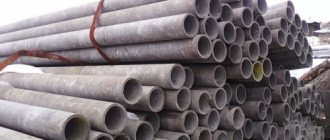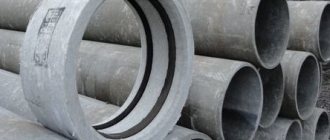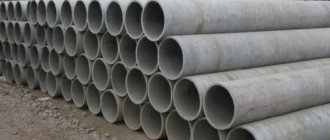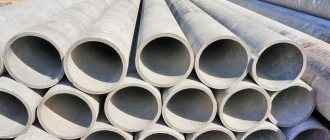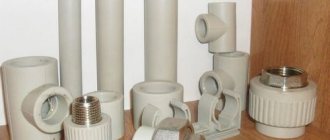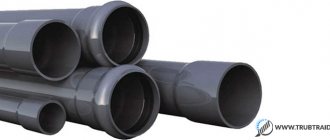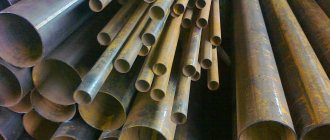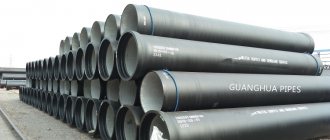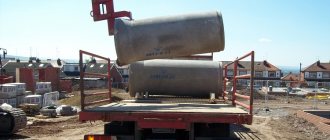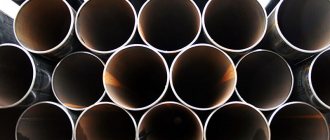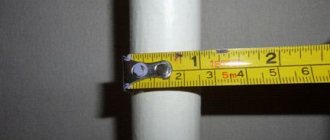Asbestos products intended for laying various pipelines must meet certain technical requirements. They are set out in the current state standard. There are several GOST standards regulating the properties of asbestos cement products. In this article we will tell you which of them are valid and which have lost their relevance.
Soviet standard for non-pressure pipes
GOST 1839 80 is a standard developed back in Soviet times. It regulated the technical properties of non-pressure asbestos pipes. The document contains information regarding product sizes.
| mm | ||||
| Conditional pass | Diameter | Wall thickness s | Length L | |
| outer D | internal D | |||
| 100 | 118 | 100 | 9 | 2950; 3950 |
| 150 | 161 | 141 | 10 | 2950; 3950 |
| 200 | 211 | 189 | 11 | 3950 |
| 300 | 307 | 279 | 14 | 3950 |
| 400 | 402 | 368 | 17 | 3950 |
According to this standard, products with a nominal bore of up to one hundred and fifty millimeters were mass-produced. The shape of the equipment should be cylindrical and straight.
In this case, minor deviations were allowed:
| mm | |||
| Conditional pass | Deviations | ||
| according to the outer diameter of the pipe | by wall thickness | along the length of the pipe | |
| 100 | ±2,5 | ±1,5 | -50,0 |
| 150 | |||
| 200 | |||
| 300 | ±3,0 | ±2,0 | |
| 400 | |||
Please note that plus tolerances for the wall thickness of pipe products were given in GOST 1839-80 as reference information. Exceeding them was not considered a sign of marriage.
State the standard regulated the physical dimensions of connecting elements. They looked like this:
| mm | ||||
| Nominal diameter of pipes | Diameter | Wall thickness s | Length l | |
| external D1 | internal D2 | |||
| 100 | 160 | 140 | 10 | 150 |
| 150 | 212 | 188 | 12 | 150 |
| 200 | 262 | 234 | 14 | 150 |
| 300 | 366 | 334 | 16 | 150 |
| 400 | 477 | 441 | 18 | 180 |
The size of the outer diameter of the connecting elements was for reference. Products whose value did not correspond to the data in the table above were not considered defective.
The couplings should not have deviations exceeding the following figures:
| mm | |||
| Nominal diameter of pipes | Deviations | ||
| by inner diameter | by wall thickness | by lenght | |
| 100 | +1,5 | ±1,5 | ±3,0 |
| -1,0 | |||
| 150 | ±2,0 | ||
| 200 | |||
| 300 | ±3,0 | ||
| 400 | |||
The product is waterproof. It is tested by hydraulic pressure. Its value should correspond to 0.4 MPa. For products belonging to the highest quality category, this indicator is 0.6 MPa. After testing, asbestos pipes should show no signs of liquid penetration.
The document contained information about what non-pressure asbestos-cement products should be called. For example, a pipe with a nominal bore of 100 mm was marked as BNT GOST 1839 80.
Product samples had to be tested in a water-saturated environment.
The equipment withstood the following loads:
| Nominal diameter of pipes, mm | Minimum load when testing pipe samples for crushing, N (kgf) |
| 100 | 4508 (460) |
| 150 | 3920 (400) |
| 200 | 3136 (320) |
| 300 | 4116 (420) |
| 400 | 4900 (500) |
Designs of the highest quality category had improved characteristics:
| Nominal diameter of pipes, mm | Minimum load when testing pipe samples for crushing, N (kgf) |
| 100 | 5253 (540) |
| 150 | 4567 (470) |
| 200 | 3646 (370) |
| 300 | 4802 (490) |
| 400 | 5253 (540) |
For 2021, this document has been replaced by another. The new standard is called GOST 31416-2009. It has certain differences from the old version.
Advantages and disadvantages
A fairly wide range of applications for pressure and non-pressure asbestos-cement pipes is due to the presence of a number of advantages in these products.
- ease of processing and simple installation;
- non-susceptibility to corrosion and to the effects of many chemically active aggressive environments;
- high level of thermal insulation;
- lighter weight than metal products;
- when creating external pipelines, there is no need to organize protection from groundwater;
- the presence of a smooth inner surface reduces the likelihood of blockages;
- affordable price. Asbestos-cement pipes will cost the consumer less than plastic and metal products.
Important! Manufacturers claim, and practice confirms the correctness of their words, that the service life of such pipes is much longer than that of rolled metal pipes - up to 40 years or more without the need for repairs.
Among the disadvantages, home craftsmen point out the significant weight of asbestos-cement products. During installation, it will be very difficult to do without lifting equipment. In addition, their disadvantages include low acid resistance and fragility.
The strength of asbestos cement pipes allows them to be laid in the ground without any pressure protection
Soviet standard for pressure pipes
To equip water supply systems, designs were produced that could withstand the pressure created by pumping systems. GOST 539 80 was developed for them. The documentation contained detailed data on all technical characteristics of structures of this type, including couplings.
The equipment was divided into classes depending on the operating pressure:
| Class symbol | Working pressure value | ||
| pipes | couplings | MPa | kgf/cm2 |
| VT6 | CAM6 | 0,6 | 6 |
| VT9 | CAM9 | 0,9 | 9 |
| VT12 | SAM12 | 1,2 | 12 |
| VT15 | SAM15 | 1,5 | 15 |
Physical properties were recorded depending on the product class. Full-length pipes were tested for rupture using internal pressure.
The samples had to be produced in such a way that they were resistant to the following loads:
| Conditional bore, mm | Hydraulic pressure, MPa (kgf/cm2), for class pipes | |||||||
| VT6 | VT9 | VT12 | VT15 | |||||
| 1 quality category | Highest quality category | 1 quality category | Highest quality category | 1 quality category | Highest quality category | 1 quality category | Highest quality category | |
| 100 | 2,4(24) | 2,6(26) | 3,6(36) | 3,8(38) | 4,8(48) | 5,0(50) | — | — |
| 150-200 | 2,1(21) | 2,3(23) | 3,1(31) | 3,2(32) | 4,2(42) | 4,3(43) | 5,2(52) | 5,3(53) |
| 250-500 | 1,8(18) | 2,0(20) | 2,7(27) | 2,8(28) | 3,6(36) | 3,7(37) | 4,5(45) | 4,6(46) |
The paper declared crushing load levels:
| Conditional bore, mm | Minimum load during crush testing, N (kgf), for pipes of class | |||
| VT6 | VT9 | VT12 | VT15 | |
| 100 | 8000(800) | 11000(1100) | 13000(1300) | — |
| 150 | 8000(800) | 11000(1100) | 15000(1500) | — |
| 200 | 8000(800) | 12000(1100) | 17000(1700) | 26000 |
| 250 | 8000(800) | 13000(1100) | 19000(1900) | 25000 |
| 300 | 9000(900) | 14000(1100) | 22000(2200) | 30000 |
| 350 | 11000(1100) | 16000(1100) | 25000(2500) | 35000 |
| 400 | 15000(1500) | 18000(1100) | 29000(2900) | 39000 |
| 500 | 16000(1600) | 22000(1100) | 34000(3400) | 39000 |
In addition, the elements had to be resistant to bending tests:
| Catch passage, mm | Minimum load during bending test, N (kgf), for pipes of class | ||
| VT6 | VT9 | VT12 | |
| 100 | 4000(400) | 4500(450) | 5000(500) |
| 150 | 9200(920) | 11000(1100) | 12200(1220) |
The document contained a lot of other information about asbestos pressure pipes. There was a section on safety requirements. There were certain rules for the acceptance and storage of structures. The equipment testing methodology was described in detail. The method of product labeling and other information was indicated.
To date, this state standard has been cancelled. Requirements for pressure pipes are contained in the new GOST 31416 2009. We will talk about it below.
Types of asbestos cement pipes
Asbestos cement is based on dispersed reinforced concrete. Moreover, asbestos in this composition performs the function of reinforcement, evenly distributed throughout the product. And the hardening cement forms a dense matrix, in the cells of which asbestos particles are present. The proportions of components in the final product are as follows:
- cement mortar – 85%;
- asbestos – 15%.
Today you can find two types of products of this type on sale.
Pressure pipes. Manufactured in accordance with the requirements of GOST 539-80. Designed for operation under high pressure conditions (ranging from 6 to 9 atmospheres). They are usually used for the construction of pressure sewer networks, water pipelines, and heating mains. In addition, similar pipe products are used to create ventilation systems and drainage collectors.
Pressure pipes are used to create networks where the movement of the working medium is carried out under pressure
Asbestos-cement non-pressure pipes. Their production is regulated by the requirements of GOST 1839-80. They are used in the construction of non-pressure pipelines for ventilation, gas supply, and sewerage. Also, asbestos-cement pipes according to GOST 1839-80 are used to create casings for laying electrical cables, supports for building envelopes, garbage chutes, etc.
Labeling, storage and transportation
6.1. The following must be painted on the outer surface of each pipe: trademark or name of the manufacturer, batch number and symbol of the pipe, as well as the inscription “do not throw”, and on each coupling - the nominal bore of the pipe for which the coupling is intended, and the batch number .
On the outer surface of at least 10% of the pipes and couplings from the batch, the Quality Control Department stamp must be painted.
6.2. The manufacturer must guarantee compliance of pipes and couplings with the requirements of this standard and accompany each batch with a document certifying their quality, which indicates:
a) name and address of the manufacturer;
b) number and date of issue of the document;
c) pipe batch number, symbol, total quantity in pieces and meters;
d) batch number of couplings, symbol, number of couplings in pieces;
e) test results of pipes (couplings);
f) designation of this standard.
(Changed edition, Amendment No. 1).
6.3. When storing, pipes and couplings must be stacked on a flat area according to their diameters: pipes in horizontal rows, and couplings in vertical rows.
On uneven ground, wooden shims should be placed under the bottom row of pipes. The bottom row of pipes must be secured.
6.4. Pipes and couplings transported by rail must be placed in special containers. Transportation of pipes and couplings without containers is allowed, and their placement must be carried out in accordance with the technical conditions for placement and fastening of asbestos-cement pipes in four-axle gondola cars, approved by the Ministry by notification of the USSR.
(Changed edition, Amendment No. 1).
6.5. When transporting by other means of transport, the pipes must be tightly secured.
Transportation of pipes in dump trucks is prohibited.
6.6. When loading and unloading, it is not allowed to hit pipes and couplings, or drop them from any height.
Crap. 1
Crap. 1
Table 1
mm
| Conditional pass | Diameter | Wall thickness | Length | |
| outer | interior* | |||
| ________________ * Inner diameter dimensions are for reference only. | ||||
| 100 | 118 | 100 | 9 | 2950; 3950 |
| 150 | 161 | 141 | 10 | 2950; 3950 |
| 200 | 211 | 189 | 11 | 3950 |
| 300 | 307 | 279 | 14 | 3950 |
| 400 | 402 | 368 | 17 | 3950 |
Note. The production of pipes with a nominal bore of more than 150 mm until January 1, 1984 is carried out at the request of the consumer with the consent of the manufacturer.
1.2. Deviations of pipe sizes from the nominal ones should not exceed the values indicated in the table. 2.
table 2
mm
| Conditional pass | Deviations | ||
| according to the outer diameter of the pipe | by wall thickness | along the length of the pipe | |
| 100 | |||
| 150 | ±2,5 | ±1,5 | |
| 200 | -50,0 | ||
| 300 | ±3,0 | ±2,0 | |
| 400 | |||
Note. The plus tolerance for pipe wall thickness is given as a guide and is not a rejection criterion. (Changed edition, Amendment No. 1).
1.3. The shape and dimensions of the couplings must correspond to those indicated in the drawing. 2 and in table. 3.
Appendix (reference). Reference weight 1 linear. m pipes
Application
Information
| Outer diameter of pipes, mm | Reference weight 1 linear. m pipes, kg |
| 118 | 6,1 |
| 161 | 9,4 |
| 211 | 13,2 |
| 307 | 25,0 |
| 402 | 40,5 |
Technical requirements
2.1. Pipes and couplings must be produced in accordance with the requirements of this standard according to technological regulations approved in the prescribed manner.
2.2. Pipes and couplings must be straight and cylindrical. Deviation from pipe straightness should not exceed:
12 mm - for pipes with a length of 2950 mm; 16 mm - » » 3950 mm.
2.3. Pipes and couplings must not have cracks, breaks or delaminations.
2.4. On the outer surface of pipes and couplings, prints of technical cloth and abrasions with a depth of no more than 2 mm are allowed, and on the inner surface - prints of the knurled surface of format rolling pins.
2.5. (Deleted, Amendment No. 1).
2.6. Pipes and couplings must be watertight and, when tested with hydraulic pressure, there must be no signs of water penetration on the outer surface.
The value of the test hydraulic pressure for pipes and couplings must be at least 0.4 MPa (4), and for pipes and couplings of the highest quality category - at least 0.6 MPa (6).
2.7. When tested for crushing in a water-saturated state, pipe samples must withstand the loads indicated in Table. 5.
Table 5
| Nominal diameter of pipes, mm | Minimum load when testing pipe samples for crushing, N (kgf) |
| 100 | 4508 (460) |
| 150 | 3920 (400) |
| 200 | 3136 (320) |
| 300 | 4116 (420) |
| 400 | 4900 (500) |
When tested for crushing in a water-saturated state, samples of pipes of the highest quality category must withstand the loads specified in Table. 6.
Table 6
| Nominal diameter of pipes, mm | Minimum load when testing pipe samples for crushing, N (kgf) |
| 100 | 5253 (540) |
| 150 | 4567 (470) |
| 200 | 3646 (370) |
| 300 | 4802 (490) |
| 400 | 5253 (540) |
2.8. The minimum breaking load when testing pipes for bending in N (kgf) should be:
for pipes with a nominal diameter of 100 mm - 1764 (180); » » » » 150 mm - 3920 (400); for pipes of the highest quality category: for pipes with a nominal bore of 100 mm - 2254 (230); » » » » 150 mm - 4704 (480);
2.9. (Deleted, Amendment No. 1).
Acceptance rules
4.1. Each batch of pipes and couplings must be accepted by the technical control service of the manufacturer in accordance with the requirements of this standard.
(Changed edition, Amendment No. 3).
4.2. Acceptance of pipes and couplings is carried out in batches. The batch size is set in the amount of shift output of one production line.
The batch must include pipes (couplings) of the same diameter.
(Changed edition, Amendment No. 2).
4.3. Acceptance rules - according to GOST 30301-95.
(Changed edition, Amendment No. 3).
4.4. When carrying out inspections and control by the consumer, the selection procedure, the number of selected pipes and couplings (sample volume) and assessment of the control results are in accordance with GOST 30301-95.
(Changed edition, Amendment No. 3).
4.5., 4.6, 4.7. (Excluded, Amendment No. 3).
4.8. (Deleted, Amendment No. 2).
